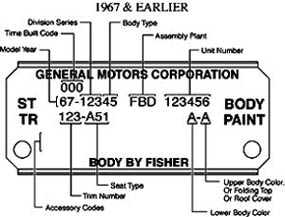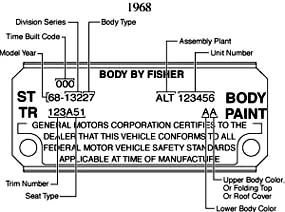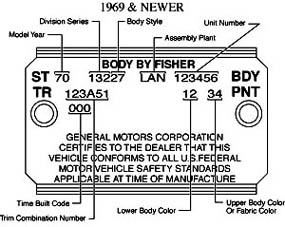![]()
 |
The body tag on your car contains vital information for the restorer. The model, body style, paint color, interior color, and date of manufacture are all found on this metal tag. On 1958-67 models, the tag is riveted to the firewall near the windshield (it’s vertical). 1968-72 models moved to the cowl panel under the hood near the windshield (it’s horizontal). All models used a tag of this sort, and from 1964-72 there are 3 basic tag styles–1964-67, 1968, and 1969-72. We’ve illustrated all 3 here, and we’ve listed the important information (and how to read it). If yours is missing, someone removed it! |
 |
 |
|
TIME BUILT CODE: The date of manufacture of the car. Consisting of 2 numbers and 1 letter, the code tells you the month and week of the month the car was built. The 2 digits represent the month (01=January, 02=Feburary, etc.) while the letter represents the week of the month (A=1st week, B=2nd week, etc.). It’s not possible to pinpoint a specific day of manufacture from the data plate, only the week of the month the car was built can be determined. Generally, most date-coded components on the car were built between 2 and 8 weeks before the build date of the car. There are, however, exceptions to this rule. MODEL YEAR: To the right of the “ST” letters (short for “Style”) are the last 2 digits of the model year of the car. “64″=1964, “70″=1970, etc. DIVISION SERIES: The first digit of this code identifies the GM division (1=Chevrolet, 2=Pontiac, 3=Oldsmobile, 4=Buick), the second and third digits identify the series (Chevelle, LeMans, Cutlass, Skylark, etc.). While the series code on the data plate may not match the series code in the V.I.N., it must be from the same family (the series code will not represent an Impala on a Chevelle data plate, or a Catalina on a LeMans plate, and so on). BODY TYPE: Following the division series is a 2-digit code that identifies the body style (or type) of the car, such as 2-door coupe, 2-door convertible, 4-door sedan, etc. ASSEMBLY PLANT: This code identifies the assembly plant where the body was mated to the chassis/driveline, and final assembly procedures were performed. This is a 1 to 3 character code, and it must match the assembly plant code in the V.I.N. UNIT NUMBER: To the left of the BODY or BDY letters is the unit number assigned at Fisher Body. This number will not match any numbers in the V.I.N. and is not significant to identification or restoration purposes. |
TRIM NUMBER: To the right of the TR letters (short for TRIM) is the interior code. This 3-digit code shows the color and style of the interior and seats. BODY COLOR: To the left of the PAINT or PNT letters are the exterior color codes. On 1964 Chevrolets, the codes are all 3 digits (including two-tone cars, which have unique 3-digit codes). From 1965 to mid-1969, Chevrolet used 2 letters–the first is for the lower body color and the second is for the roof paint, vinyl top or convertible top color. Buick, Olds and Pontiac used this 2-letter system from 1964 to mid-1969. From mid-1969 to 1972, all divisions used a 2-digit code for the lower color, followed by a 2-digit code for the roof paint, or a letter for the vinyl roof or convertible top color. ACCESSORY CODES: On 1967-and-earlier models only, there may be accessory codes listed on the data plate. These codes indicate certain options on the car. Some of these codes have been decoded on Chevrolet and Pontiac vehicles, while Buick and Olds are still a mystery. The following types of equipment have been listed on data plates that have been decoded: tinted glass, transmission, console, air conditioning, radio, mirrors, rear defroster, seat belts, and bumper guards. These codes will not appear on 1968-and-later plates. Accessory codes reappear with a different format in 1970 on various cars. SEAT TYPE: There may or may not be an additional code following the trim code that identifies the type of seat installed in the car. These codes break down as follows: A41 = 4-way front power seat (bench) |






